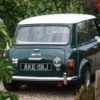If you are going to experiment with the timing settings, invest in an advance (dial back) timing light as opposed to the "regular" type. With the advance light you can start thinking about your timing from the top down instead of from idle up.
- Bring the engine to temperature.
- Connect the advance timing light and set it for 32 degrees.
- Use the carb's idle screw to bring the engine speed up to 4000 RPM.
- Adjust your distributor position until your ZERO timing mark lines up. (Remember... the light is set to 32 degrees)
- Lock the distributor down and return the idle speed to normal.
- Drive the car placing it under heavy load by doing something like driving uphill in too high a gear. Try to make it knock and ping.
- If any knocking or pinging is heard, retard the timing by 2 degrees from what it is and repeat the test drive. Do this until no more knocking or pinging is heard.
At 4000 RPM all of your distributor's mechanical advance should have taken place. Setting the spark timing with the mechanical advance fully on will set the max advance your engine can handle for its state of build, general condition, and the grade of fuel you are using. As long as you do not change anything (including the grade of fuel you buy) you can then measure the idle speed and idle speed advance using the timing light and tach. You can use those as your settings for future (idle speed) tune ups.
This would not apply to the CSI or 123 distributors with their own unique built in electronic advance curves. For those products, follow the manufacturer's method of setting the ignition timing. Obviously this method also has no application on mapped ignition systems.















